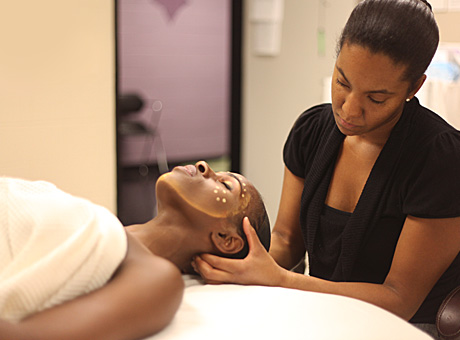
Dionne Vernon, PT 10, performs a manual treatment for the cervical spine on "The Lion King" character Nala (Nokubonga Khuzwayo).

Dionne Vernon, PT 10, performs a manual treatment for the cervical spine on "The Lion King" character Nala (Nokubonga Khuzwayo).
After short stints in more traditional physical therapy settings, Dionne Vernon, PT 10, landed what many might consider a plum role. For the past year, Vernon has been traveling with Disney’s “The Lion King” as a full-time physical therapist. When the show ran at St. Louis’ Fox Theatre in August, Outlook talked with Vernon about her interesting and somewhat unusual career path.
How did you get involved with “The Lion King”?
I was always involved in theatre as a performer, even before I studied physical therapy, and I knew I eventually wanted to work in dance or performing arts physical therapy. A friend introduced me to a woman who books touring physical therapists; after interviewing with her, I was invited to join NeuroTour Physical Therapy in Atlanta, where I completed additional training in manual skills I would need on the road. Then in mid-October 2011, I started with “The Lion King” in Buffalo, N.Y., and I’ve been on a joyride ever since!
Why does a musical need a physical therapist?
Musicals consist of choreography, acting and singing — all while effortlessly moving on various stage qualities, in elaborate costumes, and so much more. With this show, there is also the element of puppets, which require a high level of finite skill to maneuver. It’s a physically demanding job, and the performers are doing things that test their bodies every night. They understand the rigor of their job and they do their best to accommodate that, but when you include the above elements and make the same movements over and over again, night after night, eventually something is going to hurt, and that's where I come in.
Do most shows have a physical therapist on staff?
Not all shows do — funding and logistics can make that difficult. I think Disney Theatrical understands the demands of the show and the needs of their performers. They care about their performers enough to put a physical therapist on the road with them. I think that’s incredible.
What is your typical day like?
(laughs) That depends. There are eight performances each week. My shift starts two hours before the show, continues throughout the show and sometimes goes on for a few minutes after the show. During that time, I treat performers and crew, complete my presets (gathering ice and setting out tape), and remain on call for any emergencies. Some performers have appointments, while others come in between scenes or at intermission. Their conditions range from shoulder pain to a strained calf muscle. These injuries sometimes occur on stage. When that happens, it is considered a "stage call," and I have to stop whatever I am doing and make that person a priority. There are times when I will be in the wings putting tape on performers so they can go back on stage to make their cue. To be perfectly honest, it is live theater, and I never know what I'm going to get. I just take Scar's advice and "Be Prepared."
Do you ever have a bad day at work?
I’ve learned that every job has it challenges, but when you love what you do, you roll with it. There are 121 people in our cast and crew, so I’m dealing with a lot of personalities. Plus everyone’s traveling, so you have a mixture of great and not-so-great times. But even with that, I still love it.
Does any one moment of this experience stand out?
I first learned about touring physical therapists when I saw a room labeled “Physical Therapist” during a backstage tour at the Fox Theatre. I was still a student at Washington University then, but thought I would love to have that job. When we got to St. Louis with “The Lion King,” I saw that same room and had a true full-circle moment.
How has your training in the School of Medicine's Program in Physical Therapy helped you with this job?
Well, the rigor alone! (laughs) The program’s focus on movement analysis has been invaluable. I don’t have the luxury of an hour to evaluate and treat someone; I have 15 to 20 minutes to evaluate, treat and get them back on stage. So I'll take the time to watch the rehearsals and as much of the show as I can to get as familiar as possible with the movement of the individual performers.
So you felt equipped to practice at the professional level?
Absolutely. When I went out into the field and saw the difference in quality of physical therapy being offered, that’s when I really appreciated my education. The faculty at Washington University take great care to make sure that you are learning. They recognize that some people are kinesthetic, some are visual, and some just like to listen; they really take each person’s learning style into consideration.
Is this your dream job?
Pretty much. I am really, really lucky and really blessed to be doing the exact thing that I’ve always wanted to do just 1½ years after graduating. One day, I will probably work on another show, and eventually I’ll have to dream a new dream, but right now I’m exactly where I’m supposed to be.